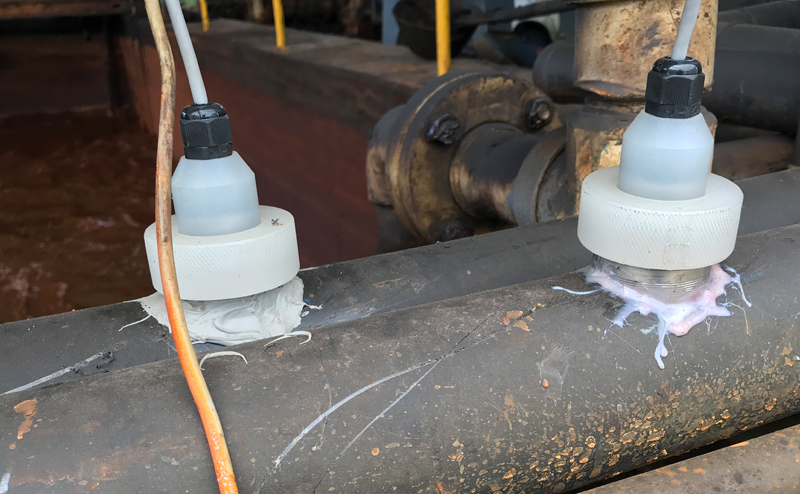
Hydrochloric Acid Calculate pH Values of Hydrochloric Acid Solutions
Wt% HCl | pH | Normality (eq/L) |
3.647 | 0.00 | 1.000 |
2.500 | 0.16 | 0.694 |
2.000 | 0.26 | 0.554 |
1.500 | 0.38 | 0.414 |
1.000 | 0.56 | 0.275 |
0.500 | 0.86 | 0.137 |
0.3647 | 1.00 | 0.100 |
0.2500 | 1.16 | 0.0685 |
0.1150 | 1.50 | 0.0316 |
0.03647 | 2.00 | 0.0100 |
0.01150 | 2.50 | 0.00316 |
0.003647 | 3.00 | 0.00100 |
0.001150 | 3.50 | 0.000316 |
0.0003647 | 4.00 | 0.000100 |
0.0001150 | 4.50 | 0.0000316 |
0.00003647 | 5.00 | 0.0000100 |
0.00001150 | 5.50 | 0.00000316 |
0.000003647 | 6.00 | 0.00000100 |
0.000001150 | 6.50 | 0.000000316 |
0.0000003647 | 7.00 | 0.000000100 |
pH of Hydrochloric Acid Acidity and Alkalinity (pH)
An acid is a substance that yields hydrogen ions (H+) when dissolved in water, while bases are substances that yield hydroxide ions (OH-). Strong acids or bases ionize nearly completely in water to yield many hydrogen ions or hydroxide ions. Pure water ionizes slightly to produce an equivalent number of [H+] and [OH-] ions. Any solution containing equal concentrations of [H+] and [OH-] is neutral. Any solution with an excess of [H+] is acidic. Any solution with an excess of [OH-] is basic.
pH Value
The relative strength of an acid or base is found by comparing the concentration of [H+] in solution with that of water. The hydrogen-ion concentration [H+] expressed as a power of 10 is known as the pH. By definition pH is equal to the negative logarithm of the hydrogen-ion concentration.
pH = -log[H+] = log 1/[H+]
The pH scale ranges from 0 to 14, with 7.0 being neutral. Solutions with a pH below 7.0 are acidic while solutions with a pH above 7.0 are basic (or alkaline).Since the pH scale is logarithmic, not linear, a solution of pH 1 would have ten times (not twice) the [H+] that a solution of pH 2. Likewise, a solution of pH 12 would be 10 times more alkaline than a solution of pH 11.
pH Calculations Involving HCl Solutions
1.Given the Wt% of an HCl solution, what is its theoretical pH value?
For pH calculations, [H+] is expressed in moles per liter. Being a strong acid, we can assume that HCl completely dissociates (ionizes) in water. Additionally, since one molecule of HCl yields one [H+], the equivalent mass is equal to the molecular mass. Therefore a one molar solution of HCl (one molecular mass per liter), yields a one molar solution of [H+].
Wt% HCl is first converted to molar concentration to determine the [H+]. The weight of 1 liter of HCl is determined by multiplying the solution concentration (Wt%) by its specific gravity (SpGr) and by 1,000 (assuming that 1 liter of water weighs 1,000 grams). Specific gravities for very dilute HCl solutions may be assumed to be 1. Weight HCl is then converted to molar concentration by dividing by the gram-molecular mass of HCl (36.47). As stated above, the molar concentration of HCl is equal to the hydrogen ion concentration [H+].
(Wt% HCl/100%)(SpGr)(1,000g/L)(mol HCl/36.47g) =mol/L HCl = mol/L [H+]
The pH is then calculated from the [H+] via the pH equation.
pH = log 1/[H+] = – log [H+]
Given the pH of an HCl solution, what is its theoretical concentration?
From the pH equation, the following relationship can be used to determine the [H+]:
[H+] = 10-pH
Again, since the hydrogen ion concentration [H+] is equal to the molar concentration of HCl ([H+] = mol/L HCl), the concentration of HCl in Wt% can be determined as follows:
(HCl mol/L)(36.47g/mol)(L/1,000g)(100%)/(SpGr) = Wt%
Equivalent Masses
In chemical reactions, equivalent amounts of reactants will combine with each other to form products. For example, NaOH + HCl –> NaCl + H2O. In this reaction, one equivalent of NaOH reacts with one equivalent of HCl to yield one equivalent of NaCl and one equivalent of H2O. The equivalent mass of a compound is equal to the gram-molecular mass of the compound divided by the number of hydrogen ions(or hydroxide ions) accepted or donated for each gram molecular unit. For acids or bases containing only one reactive hydrogen ion or hydroxide ion the equivalent mass is equal to the molecular mass. The molecular mass of HCl is 36.47. The equivalent mass of HCl is also 36.47. The molecular mass of any compound in grams (gram-molecular mass) contains the same number of molecules, Avogadro’s number (6.02×1023). This quantity of molecules is referred to as a mole. A molar solution has its concentration expressed as the number of gram-molecular masses (moles) of substance per liter.Solution concentrations expressed in equivalents are referred to as Normal solutions. A 1 N solution (a 1 normal solution) contains 1 equivalent mass per liter;a 2 N solution contains 2 equivalent masses per liter,and so on.
